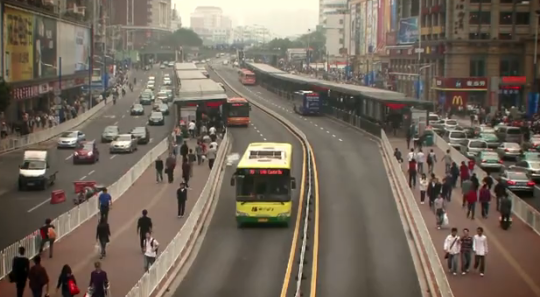As Dave Roberts pointed out in his post earlier today, if this country has any hope of getting serious about energy security, we’re going to have to get serious about transit.
But what form should that transit take, exactly?
If you look around the world, you’ll see a lot of cities embracing Bus Rapid Transit. BRT systems have dedicated bus lanes and prepaid boarding, and they have been a key part of the transportation scene in Latin American cities like Curitiba, Brazil, and Bogotà, Colombia, for many years. Advocates say they can provide many of the benefits associated with rail transit — quick trips, comfortable facilities, fewer cars — without the astronomical costs and long timelines of building subways or light rail. The latest release from Streetfilms, above, shows the spanking-new system in Guangzhou, China, which is integrated with the city’s metro and a bikeshare program. It’s currently moving 800,000 passengers every day.
So why don’t we hear more about BRT in the United States? The Brookings Institution held a panel last month called “Latin America’s Bus Rapid Transit Boom — Lessons for U.S. Public Transportation,” which aimed in part at addressing the image problem that bus transportation has in the U.S.:
Often regarded as a second-best option vis-à-vis rail alternatives, the successful implementation of BRT requires concerted efforts to enhance its image, funding and planning. Valuable lessons can be extracted from Latin America’s experience with bus rapid transit, lessons that can serve as a point of departure to discuss the applicability of BRT in the United States.
Gov. Dannel Malloy, a Connecticut Democrat, might be studying up on that Brookings panel right now. He announced he is going to “aggressively pursue” a BRT-style project (dubbed a “Busway”) that would connect Hartford and New Britain. The project has 80 percent financial backing from the federal government, and is being praised by many transportation advocates in the region. But it has its detractors, too. At $600 million, it has been criticized as too expensive, too disruptive to the communities it would pass through, and undermining of potential rail development.
BRT critics say that Americans don’t like riding buses, that the systems are expensive for the service they provide, and that they are a greater source of pollution than rail.
But as a New Yorker who has watched the much-needed Second Avenue Subway line being alternately built and not built for my entire life (scheduled opening is now in 2017), I can see the benefits of a more quickly implemented rubber-on-asphalt solution, like the Select Bus Service that New York is piloting right now. That’s coming from someone who really loves trains.
This Streetfilms overview about BRT is one good place to get an idea about how such systems work, and the comments — there and on the Guangzhou video — will give you an insight into the ongoing and sometimes testy debate.




